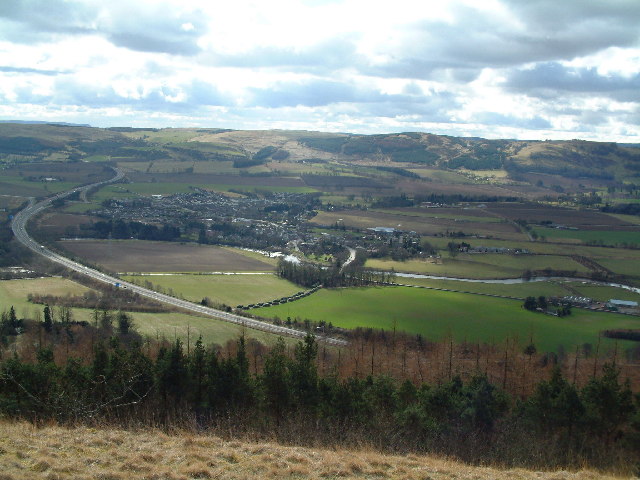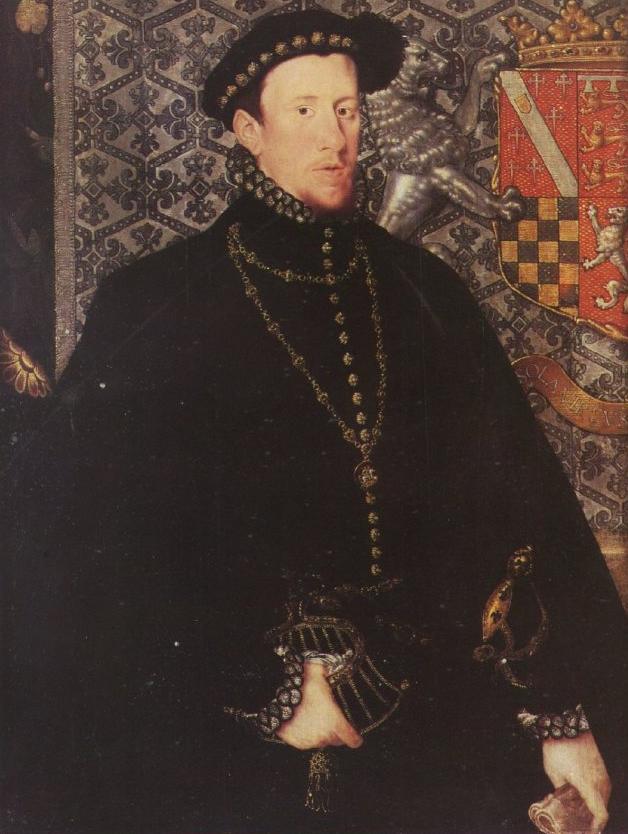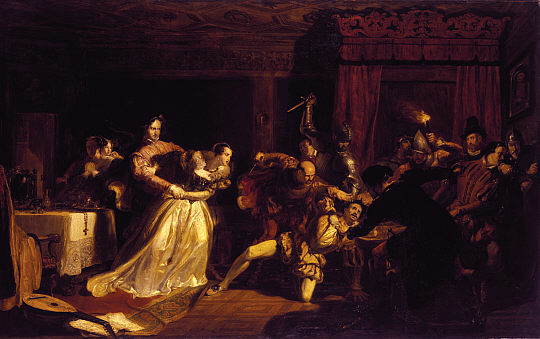|
Patrick Ruthven, 3rd Lord Ruthven
Patrick Ruthven, 3rd Lord Ruthven (c. 1520 – 13 June 1566) played an important part in the political intrigues of 16th century Scotland. He succeeded to the lordship in December 1552. The Ruthven lordship encompassed the offices of Provost and Constable of Perth, and Sheriff of Strathearn. Life Patrick was the son of William Ruthven, 2nd Lord Ruthven and Janet Haliburton, heiress of the Lord Haliburton of Dirleton, Haliburtons of Dirleton Castle. Quest for wealth and advancement During the war of the Rough Wooing, Patrick, Master of Ruthven, aided the English cause. In 1548 the English commander William Grey, 13th Baron Grey de Wilton, Grey of Wilton noted that he had been at the English-held Yester Castle with his servants in their "Jack of plate, jacks" wearing red scarves. He wanted to profit by delivering Perth, Scotland, Perth to the English. His father was provost of the town, and Patrick offered it to Andrew Dudley, Sir Andrew Dudley, a brother of the John Dudley, 1st D ... [...More Info...] [...Related Items...] OR: [Wikipedia] [Google] [Baidu] |
Strathearn
Strathearn or Strath Earn (), also the Earn Valley, is the strath of the River Earn, which flows from Loch Earn to meet the River Tay in the east of Scotland. The area covers the stretch of the river, containing a number of settlements in Perthshire. It shares a name with a modern ward used for elections to Perth and Kinross Council. Strathearn was also the name of an ancient province of the Kingdom of Alba, under the authority of a mormaer and then an Earl. More recently, the name has since been used in a number of titles used by the British royal family. History The historic province of Strathearn was bounded on the north by Atholl, north west by Breadalbane, south west by Menteith, south east by Fife, and on the east by '' Perthia''. The earliest attested mormaer of Strathearn is Mael Ísu I, who is recorded fighting alongside David I at the Battle of the Standard in 1138. Unlike some provinces where the holder of the office of mormaer rotated between kin- ... [...More Info...] [...Related Items...] OR: [Wikipedia] [Google] [Baidu] |
Treaty Of Berwick (1560)
The Treaty of Berwick was negotiated on 27 February 1560 at Berwick-upon-Tweed. It was an agreement made by the representative of Queen Elizabeth I of England, the Duke of Norfolk, and a group of Scottish nobles, the Lords of the Congregation. The treaty set the terms under which an English fleet and army would come to Scotland to expel the French troops who were defending the Regency of Mary of Guise. The Lords were trying both to expel the French and to effect the Scottish Reformation, and this led to rioting and armed conflict. England and the Scottish Lords of the Congregation The leader of the Lords of the Congregation was the Duke of Chatelherault. He had formerly been Regent, but in this treaty was described as "second person", meaning that he was heir to the throne after the 17-year-old Mary, Queen of Scots. His representatives at Berwick were James Stewart, 1st Earl of Moray, Patrick, Lord Ruthven, Sir John Maxwell of Terregles, William Maitland younger of Lethin ... [...More Info...] [...Related Items...] OR: [Wikipedia] [Google] [Baidu] |
Regent Morton
James Douglas, 4th Earl of Morton (c. 1516 – 2 June 1581) was a Scottish nobleman. He played a leading role in the murders of Queen Mary's confidant, David Rizzio, and king consort Henry Darnley. He was the last of the four regents of Scotland during the minority of James VI. He was in some ways the most successful of the four since he won the civil war that had been dragging on with the supporters of the exiled Mary, Queen of Scots. However, he came to an unfortunate end, executed by means of the Maiden, a predecessor of the guillotine. Biography Early life James Douglas was the second son of Sir George Douglas of Pittendreich, Master of Angus, and Elizabeth Douglas, daughter of David Douglas of Pittendreich. He wrote that he was over 61 years old in March 1578, so was probably born around 1516. Before 1543, he married Elizabeth, daughter of James Douglas, 3rd Earl of Morton, and became known as the "Master of Morton". In 1553, James Douglas succeeded to the title ... [...More Info...] [...Related Items...] OR: [Wikipedia] [Google] [Baidu] |
James Grant (1822–1887)
James Grant (1822–1887) was a Scottish novelist and miscellaneous writer. Grant was born in Edinburgh, Scotland, and was a distant relation of Sir Walter Scott. He was a prolific author, writing some 90 books, including many yellow-backs. Titles included ''Adventures of an Aide-De-Camp'', ''One of "The Six Hundred"'', ''The Scottish Musketeers'' and ''The Scottish Cavalier''. Many of his 56 novels are about important characters and events in Scottish history. In 1853 he founded the National Association for the Vindication of Scottish Rights. Grant is known for his six-volume ''Old And New Edinburgh'', published in 1880 by Cassell. Biography Grant was born at Edinburgh 1 August 1822. He was the eldest son of John Grant and the grandson of James Grant of Corrimony (1743?–1835) advocate. From his grandfather, James Grant, the novelist inherited strong Jacobite proclivities, and he was connected by descent with the Veitches of Dawyck, Peeblesshire, and thus possessed a st ... [...More Info...] [...Related Items...] OR: [Wikipedia] [Google] [Baidu] |
Grassmarket
The Grassmarket is a historic market square, market place, street and event space in the Old Town, Edinburgh, Old Town of Edinburgh, Scotland. In relation to the rest of the city it lies in a hollow, well below surrounding ground levels. Location The Grassmarket is located directly below Edinburgh Castle and forms part of one of the main east-west vehicle arteries through the city centre. It adjoins the Cowgatehead/Cowgate and Candlemaker Row at the east end, the West Bow, Edinburgh, West Bow (the lower end of Victoria Street, Edinburgh, Victoria Street in the north-east corner, King's Stables Road, Edinburgh, King's Stables Road to the north-west, and the West Port, Edinburgh, West Port to the west. Leading off from the south-west corner is the Vennel, on the east side of which can still be seen some of the best surviving parts of the Flodden Wall, Flodden and Telfer Wall, Telfer town walls. The view to the north, dominated by the castle, has long been a favourite subject of p ... [...More Info...] [...Related Items...] OR: [Wikipedia] [Google] [Baidu] |
David Rizzio
David Rizzio ( ; ; – 9 March 1566) or Riccio ( , ) was an Italian courtier, born in Pancalieri close to Turin, a descendant of an ancient and noble family still living in Piedmont, the Riccio Counts di San Paolo e Solbrito, who rose to become the private secretary of Mary, Queen of Scots. Mary's husband, Henry Stuart, Lord Darnley, Lord Darnley, is said to have been jealous of their friendship because of rumours that Rizzio had impregnated Mary, and he joined in a conspiracy of Protestant nobles to murder him, led by Patrick Ruthven, 3rd Lord Ruthven. Mary was having dinner with Rizzio and a few ladies-in-waiting when Darnley joined them, accused his wife of adultery and then had a group murder Rizzio, who was hiding behind Mary. Mary was held at gunpoint and Rizzio was stabbed numerous times. His body took 57 dagger wounds. The murder was the catalyst of the downfall of Darnley, and had serious consequences for Mary's subsequent reign. Career Rizzio (whose name appears in ... [...More Info...] [...Related Items...] OR: [Wikipedia] [Google] [Baidu] |
Henry Stuart, Lord Darnley
Henry Stuart, Lord Darnley (1546 – 10 February 1567) was King of Scotland as the second husband of Mary, Queen of Scots, from 29 July 1565 until his murder in 1567. Lord Darnley had one child with Mary, the future James VI of Scotland and I of England. Through his parents, he had claims to both the Scottish and English thrones.Elaine Finnie Greig, 'Stewart, Henry, duke of Albany ord Darnley(1545/6–1567)', Oxford Dictionary of National Biography, Oxford University Press, 2004; online edn, Jan 200accessed 4 March 2012/ref> Less than a year after the birth of his son, Darnley was murdered at Kirk o' Field in 1567. Many contemporary narratives describing his life and death refer to him as simply ''Lord Darnley'', his title as heir apparent to the Earldom of Lennox. Origins He was the second but eldest surviving son of Matthew Stewart, 4th Earl of Lennox, by his wife Lady Margaret Douglas, which supported his claim to the English succession. Darnley's maternal grandparents ... [...More Info...] [...Related Items...] OR: [Wikipedia] [Google] [Baidu] |
William Maitland Of Lethington
William Maitland of Lethington (1525 – 9 June 1573) was a Scottish politician and reformer, and the eldest son of poet Richard Maitland. Life He was educated at the University of St Andrews. William was the renowned "Secretary Lethington" to Mary, Queen of Scots. As her Secretary of State from 1558, he played a prominent part in the various movements of his time, but did not gain the confidence of any party. He adhered to the party of James Stewart, 1st Earl of Moray, illegitimate half-brother of the Queen, against the extreme measures of John Knox, and generally held his own against the preachers. His knowledge of foreign, and especially of English, politics and his general ability were assets of the highest value. The lords sent Maitland to England to ask for assistance from Elizabeth, and his constant aim throughout his political career was to bring about a union between the two crowns. He was the guest of Ralph Sadler at Sutton House. He proved a highly astute amb ... [...More Info...] [...Related Items...] OR: [Wikipedia] [Google] [Baidu] |
Mary, Queen Of Scots
Mary, Queen of Scots (8 December 1542 – 8 February 1587), also known as Mary Stuart or Mary I of Scotland, was List of Scottish monarchs, Queen of Scotland from 14 December 1542 until her forced abdication in 1567. The only surviving legitimate child of James V of Scotland, Mary was six days old when her father died and she inherited the throne. During her childhood, Kingdom of Scotland, Scotland was governed by regents, first by the heir to the throne, James Hamilton, Earl of Arran, and then by her mother, Mary of Guise. In 1548, she was betrothed to Francis II of France, Francis, the Dauphin of France, and was sent to be brought up in Kingdom of France, France, where she would be safe from invading Kingdom of England, English forces during the Rough Wooing. Mary Wedding of Mary, Queen of Scots, and Francis, Dauphin of France, married Francis in 1558, becoming queen consort of France from his accession in 1559 until his death in December 1560. Widowed, Mary Entry of Mary, Q ... [...More Info...] [...Related Items...] OR: [Wikipedia] [Google] [Baidu] |
Thomas Randolph (diplomat)
Thomas Randolph (1523–1590) was an English ambassador serving Elizabeth I of England. Most of his professional life he spent in Scotland at the courts of Mary, Queen of Scots, and her son James VI. While in Scotland, he was embroiled in marriage projects and several upheavals. In 1568-1569 he was sent on a special embassy to Russia, visiting the court of Ivan the Terrible. Randolph was also a Member of Parliament: for New Romney in 1558, Maidstone 1584, 1586 and 1589, Grantham 1559 and St Ives 1558 and 1572. Exile in France Thomas Randolph was born in 1523, the son of Avery Randolph of Badlesmere, Kent and Anne Gainsford (NOT the lady-in-waiting to Anne Boleyn). He entered Christ Church, Oxford at the time of its foundation, and graduated B.A. in October 1545, and B.C.L. in 1548. Shortly afterwards he became a public notary; and in 1549 he was made principal of Broadgates Hall (now Pembroke College), Oxford. He continued there until 1553, when the Protestant persecutions u ... [...More Info...] [...Related Items...] OR: [Wikipedia] [Google] [Baidu] |
Edinburgh Castle
Edinburgh Castle is a historic castle in Edinburgh, Scotland. It stands on Castle Rock (Edinburgh), Castle Rock, which has been occupied by humans since at least the Iron Age. There has been a royal castle on the rock since the reign of Malcolm III of Scotland, Malcolm III in the 11th century, and the castle continued to be a royal residence until 1633. From the 15th century, the castle's residential role declined, and by the 17th century it was principally used as a military garrison. Its importance as a part of Scotland's national heritage was recognised increasingly from the early 19th century onwards, and various restoration programmes have been carried out over the past century and a half. Edinburgh Castle has played a prominent role in History of Scotland, Scottish history, and has served variously as a Palace, royal residence, an arsenal, a treasury, a national archives, national archive, a Mints of Scotland, mint, a prison, a military fortress, and the home of the Honou ... [...More Info...] [...Related Items...] OR: [Wikipedia] [Google] [Baidu] |
Edward VI Of England
Edward VI (12 October 1537 – 6 July 1553) was King of England and King of Ireland, Ireland from 28 January 1547 until his death in 1553. He was crowned on 20 February 1547 at the age of nine. The only surviving son of Henry VIII by his third wife, Jane Seymour, Edward was the first English monarch to be raised as a Protestant. During his reign, the realm was governed by a regency council because Edward never reached maturity. The council was first led by his uncle Edward Seymour, Duke of Somerset (1547–1549), and then by John Dudley, Duke of Northumberland (1550–1553). Edward's reign was marked by many economic problems and social unrest that in 1549 erupted into riot and rebellion. An expensive Rough Wooing, war with Kingdom of Scotland, Scotland, at first successful, ended with military withdrawal from Scotland and Boulogne-sur-Mer in exchange for peace. The transformation of the Church of England into a recognisably Protestant body also occurred under Edward, who too ... [...More Info...] [...Related Items...] OR: [Wikipedia] [Google] [Baidu] |









